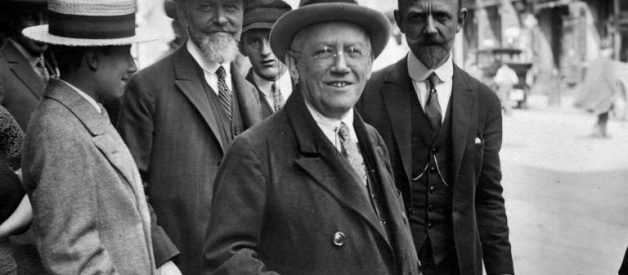How ?Laemmle?s Folly? became a world-class theme park that changed the industry forever.
 One of the original ? Glamour Trams? exploring the Western Sets of the backlot. [Security Pacific National Bank Collection at Los Angeles Public Library]
One of the original ? Glamour Trams? exploring the Western Sets of the backlot. [Security Pacific National Bank Collection at Los Angeles Public Library]
Welcome to the World Famous Universal Studios Hollywood Studio Tour! Today, we are heading way back into the archives of Universal Pictures to discover how they came to own a mountainous crop of land smack dab in the middle of what would become the famed Hollywood Hills. Please keep your hands, arms, and feet inside the vehicle at all times and watch out for rouge directors, movie stars, and ever-changing landscapes. ?
The lasting ramifications of Universal Studios Hollywood and its original theme park studio tour still reverberate across the theme park universe (pardon the pun) with theme parks around the world including Disney?s Hollywood Studios still taking cues from what Universal Studios Hollywood was doing way back in 1915 when films didn?t even have audio ? much less audio-animatronics.
Since its humble beginnings, Universal Studios Hollywood has always been an enigma. This paradox of a fully-functioning top Hollywood film and television studio that sits just feet from one of the world?s top theme parks could exist nowhere else except in the Hollywood Hills.
The founder of Universal City, Carl Laemmle envisioned a city dedicated to the movies. The studio tour, once simply a method of attracting audiences and publicity to Universal Films, transformed over time into a worldwide empire with revenues in the billions. While most early film studios are now mainly fading celluloid and memories, ?Laemmle?s Folly? continues to grow in popularity, offering new generations of film lovers the chance to go behind the scenes of their favorite films.
A Rebel Filmmaker With a Dream
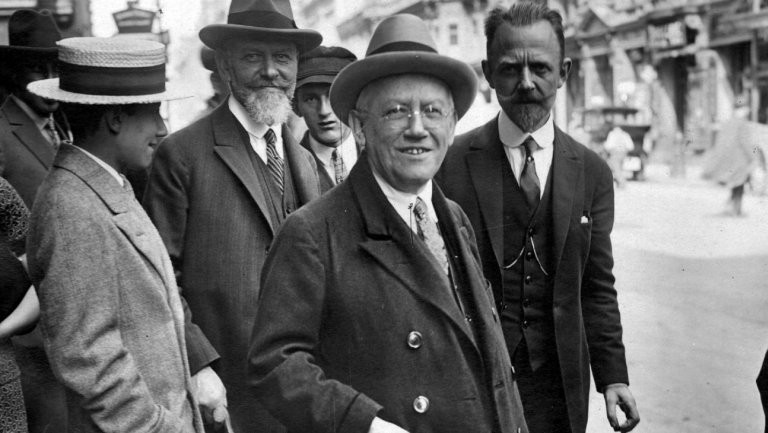 Carl Laemmle [Getty Images]
Carl Laemmle [Getty Images]
Before prohibition and the Great Depression rocked the country, even before Walter and Cordelia Knotts started selling their fried chicken dinners at their berry farm in Buena Park, Carl Laemmle was faced with a conundrum in March of 1912. Two years after leading a massive merger, his film production company desperately needed more land.
This was not altogether an unpleasant problem for Carl Laemmle, an immigrant from Bavaria, Germany, who had become obsessed with Motion Pictures. Laemmle came to America in 1884 and opened a five and dime store in Wisconsin.
Years later, his life?s direction would change completely when he visited what was called a ?Nickelodeon,? a movie theater with an admission fee of just one nickel. The magical, flickering images sparked his imagination and in 1906 he opened his first movie theatre in Chicago in a vacant building on Milwaukee Avenue. He painted the facade white and the venue became known as The White Front Theater. It was an immediate success with lines around the block.
However, the good times would not last long. In 1909, the New York-based Motion Pictures Patents Company (MPPC) imposed a massive two-dollar license fee upon independent theatre operators like Laemmle. The MPPC was led by inventor Thomas Edison (yes? that Thomas Edison) and they wanted to control the infant film industry, which was at their mercy given that MPPC held the patent on all motion picture cameras. Laemmle, always the rebel, recognized that producing his own films would enable him to circumvent the hefty licensing fees and production regulations imposed by MPPC.

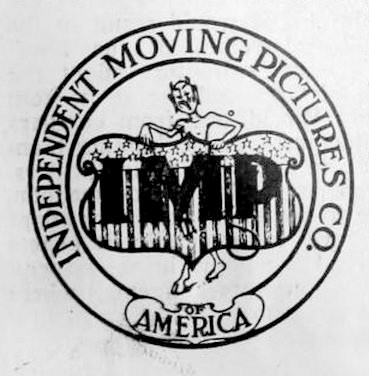 The original White Front Theater (Left) and Independent Moving Pictures?s logo (Right)
The original White Front Theater (Left) and Independent Moving Pictures?s logo (Right)
Within a few months, Laemmle moved to New York and started his own movie company in 1909 called Independent Moving Pictures (IMP). His sense of humor and his true feelings about the MPPC were on display when he adopted a playful impish demon as the logo for the studio.
In mid-1910, he oversaw a massive and unprecedented merger of several already-established film production companies and emerged as its President. The merger gave them the name, Motion Picture Distributing & Sales Company and provided the use of the Champion Film Company studio in Fort Lee, New Jersey ? the film production capital of the world at the time!
Still, it was New Jersey so inclement weather and the MPPC?s continued litigation against Laemmle soon made New Jersey inhospitable. To make his films, Laemmle was willing to violate the law; he was personally sued 289 times for intellectual property violations. The mainstream film industry held all of the important patents on film equipment and sued anyone who dared make films without their permission. They litigated to try to weaken the threat from filmmakers like Laemmle who were bringing to America radical ideas like the ?feature? film (longer than 20 minutes), credits for actors, and other innovations (such as the chase sequence).
In 1910, MPPC even issued an injunction against Laemmle for the knockoff camera being used for their motion pictures, claiming that it was an infringement on their patents. They later lost, but, Laemmle, along with a handful of other film producers, fled west to California. They were in search of the infamous California weather that allowed for year-round filming and for a place to hide from MPPC?s prying eyes.
Laemmle?s company began production in Los Angeles in 1910. However, Laemmle didn?t join them on the West Coast until May of 1912 ? just a month before the cobbled together Motion Picture Distributing and Sales Company collapsed. The assets of his original production company, Independent Moving Pictures, was transferred to the newly incorporated Universal Film Manufacturing Company. Little did they know, the Universal logo would be appearing on films for the next 100 years. And so, Universal was born as a renegade studio, an outlaw, with radically different ideas of what film could be.
Meanwhile, on the east coast, the United States Supreme Court ruled against the MPPC in 1912 and once again in 1915. The Court stated that the MPPC was in violation of the 1890 Sherman Antitrust Act. By 1917, the MPPC would cease to exist? but it was too late. The creative center of the film industry had moved to Hollywood.
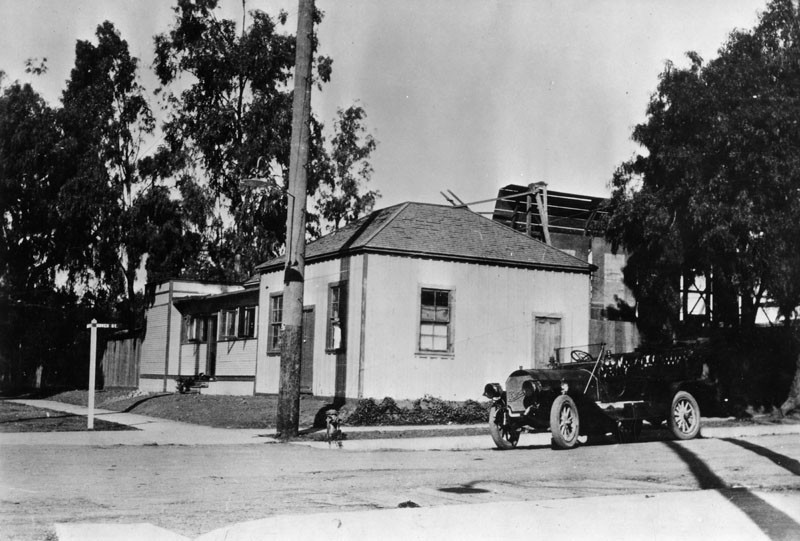 Nestor Company Studio ? Known as ?Gower Gulch?
Nestor Company Studio ? Known as ?Gower Gulch?
However, Laemmle was likely expecting a little bit more from this infamous Hollywood that what he found when he arrived in Los Angeles, a city no doubt in its infancy, which at the time had a population of about 500,000 people. To solve his land problem, one of his first acts in Los Angeles was to buy the Nestor Company Studio at Sunset Boulevard and Gower Street. The studio was the first permanent motion picture studio in Hollywood and it had developed a silly nickname. It was known around town as ?Gower Gulch? due to the actors dressed as cowboys and Indians waiting on that corner to be cast in Westerns.
In fact, prior to being bought by Laemmle and Universal, Nestor?s staff had been successfully churning out three pictures a week from their humble studio, which was a former tavern rented from widow Marie Blondeau with two film stages. Luckily, the building conveniently also offered spacious grounds, enabling several films to be shot simultaneously. Granted, motion pictures didn?t yet have sound. When a script called for a more expansive location, Nestor?s crews shot in the San Fernando Valley on land leased from the Providencia Land and Water Development Company ? this was later called the ?Oak Crest Ranch? property once Universal bought the property.
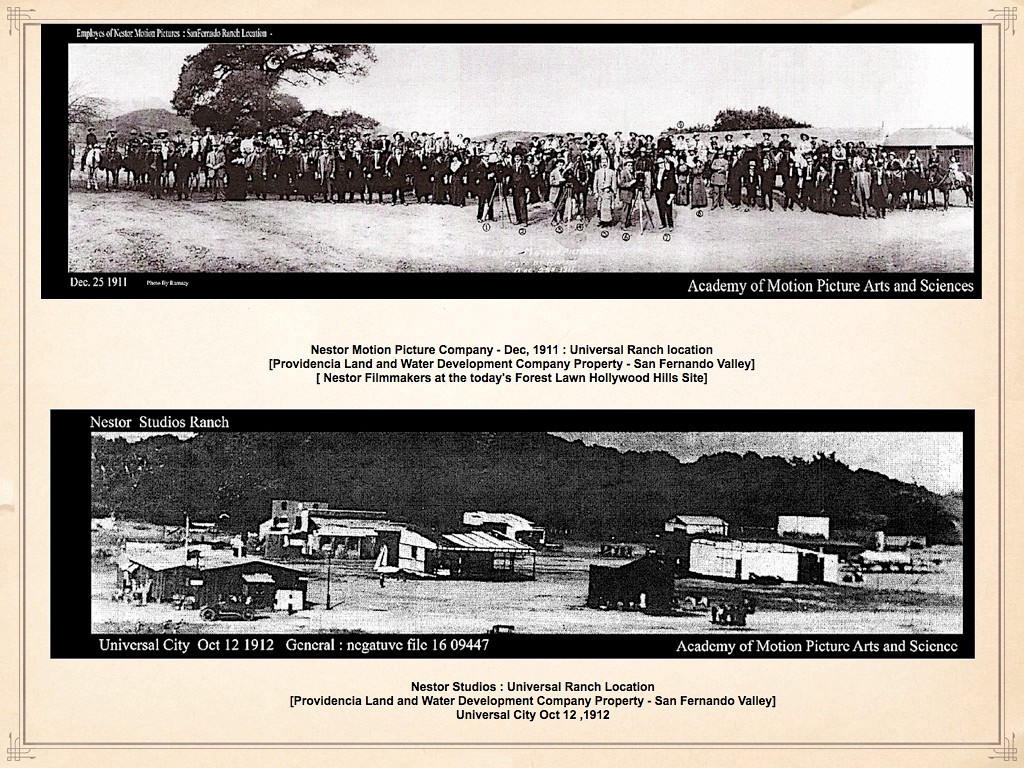 The ?Oak Crest Ranch? Property
The ?Oak Crest Ranch? Property
However, lugging equipment and personnel to on location shoots required precious time and money. In order to increase the efficiency and profits of his new acquisition, Laemmle decided to build the world?s first city dedicated entirely to making movies. And hence, the idea for Universal Studios Hollywood was born.
Laemmle went about setting up makeshift stages on the ?Oak Crest Ranch? property and the production of western films began on the site in 1912. On December 6, 1912, an informal studio opening was held at the Oak Crest property. The public was invited to tour the ranch and watch a Bison Pictures cowboys and Indians battle.
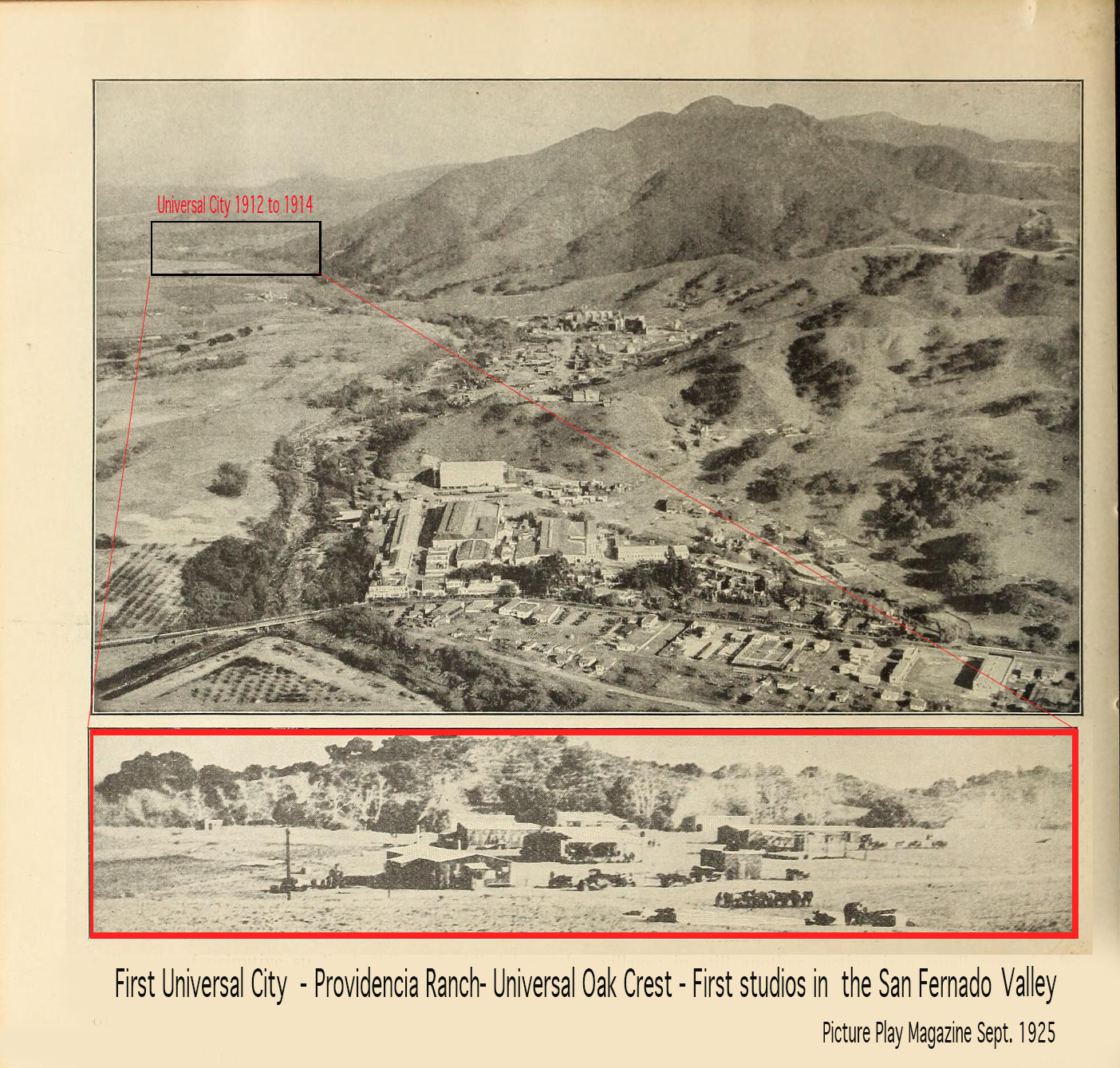
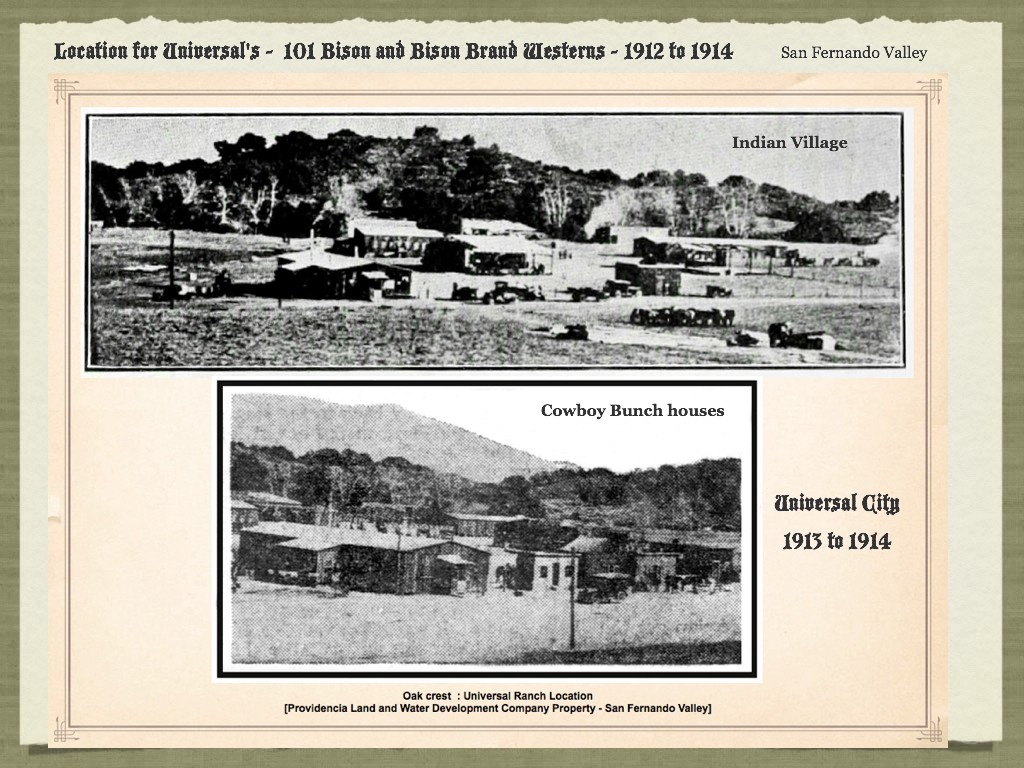 The First Universal City on the ?Oak Crest Ranch? property in 1913
The First Universal City on the ?Oak Crest Ranch? property in 1913
In an attempt to generate some publicity, Laemmle dubbed the Oak Crest Ranch, ?Universal City? on July 10, 1913. In August of 1913, he invited fifty Chimallo Indians along with 100 horses from the Isleta reservation near Albuquerque, New Mexico, to move in permanently at Universal City. This group of Native Americans performed in his films and lived on the new property in tepees. He began to attract visitors with bus excursions to the Oak Crest ranch from downtown Los Angeles in September of that year.
However, shortly thereafter, Laemmle decided the Oak Crest Ranch location was actually too small for him to consolidate all the west coast operations and build his film city.
In March 1914, Laemmle decided to buy a 230-acre chicken farm known as the Taylor Ranch from the Lankershim Land, Water Development Co., for only $165,000. After the deal closed, he started construction on his so-called ?film city?. When Laemmle saw the ranch property for the first time, his car actually got stuck in the mud and had to be pulled out by Jumbo, an elephant that was working on a film at the time.
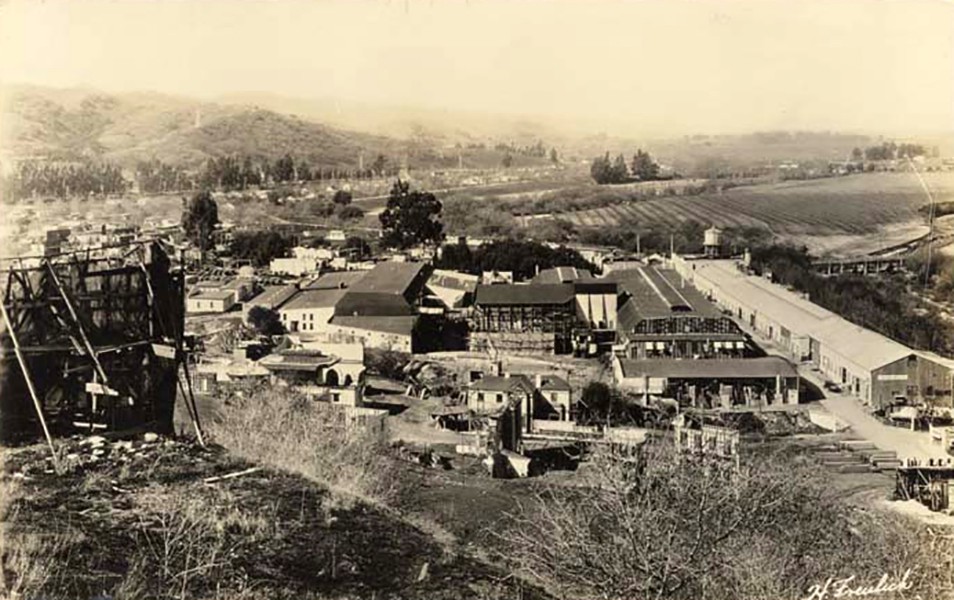 An early birds-eye view of Universal City, built on the Taylor Ranch property, in the 1910s. [California State University]
An early birds-eye view of Universal City, built on the Taylor Ranch property, in the 1910s. [California State University]
If you can believe it, his film colleagues made fun of him and often referred to the buying of the chicken farm as ?Laemmle?s Folly.? Despite this, the burgeoning movie mogul hired hundreds of construction workers to realize his vision for, what would come to be called, Universal City.
While filming continued on his newly acquired grounds in the San Fernando Valley, Laemmle continued to construct and install numerous sets and stages as well as a bank, horse corral, cafe, post office, school and zoo. When all was said and done, Laemmle invested $1 million in studio facilities. He also relocated several small buildings, including the tavern from Gower Studios and other buildings from the Oak Crest Ranch property.
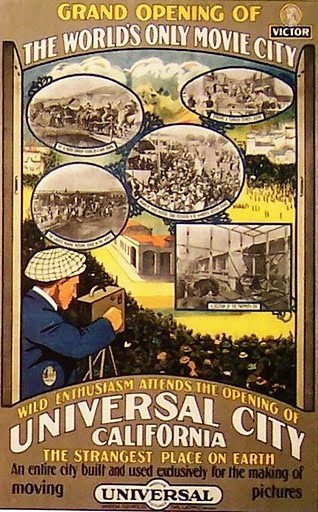
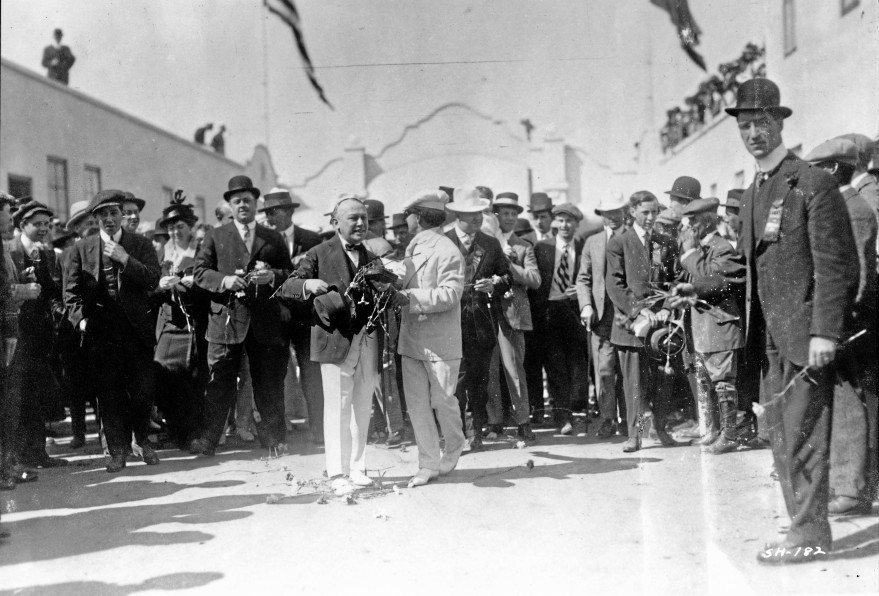 Opening day of at Universal Studios Hollywood March 15, 1915. [Universal Handout Photo]
Opening day of at Universal Studios Hollywood March 15, 1915. [Universal Handout Photo]
In 1915, always the showman, Laemmle arranged for a special Santa Fe train to leave Chicago on March 7, 1915, and head toward Universal City, California. Laemmle spent eight days on the transcontinental railroad traveling from Chicago to Los Angeles to drum up publicity for the official grand opening of Universal City. The ceremonies were set for March 15. When the train arrived, more than 20,000 people were waiting, including Buffalo Bill Cody.
To celebrate his creation, now the largest film production facility in the world, Laemmle arranged for two days of festivities that included a parade, and, in a bizarre foreshadowing of things to come, a western stunt show, the demolition of a bridge and a simulated flash flood; three attractions that would later become fixtures of the early Universal Studio Tour. Thousands of spectators cheered the breathtaking spectacles on the first day.
A studio press release proclaimed:
?They are to witness the opening of the first municipality ? the first city or community ? to be devoted exclusively to the manufacture of motion pictures. The city ? this Universal City of which the picture world has talked for months ? is the realization of a dream by Carl Laemmle not more than ten years ago.?
Miss Laura Oakley, chief of the Universal City Police, handed Laemmle a gold key. Laemmle remarked, ?I hope I didn?t make a mistake coming out here.? Just in case, the chicken ranch remained operational.
However, the excitement came to a tragic end on day two of the opening when a hired aircraft suffered a weather-related crash, killing the stunt pilot. In the aftermath, Laemmle dispersed the crowds and closed the studio to the public. However, he still retained his dream of inviting people into his movie city.
Despite the setbacks, Universal survived ? and prospered. Along with 20th Century Fox and Paramount, Universal was one of the most important ?outlaw? film studios in the early history of film, a decisive force in making Hollywood the center of American movies ? and in making the United States a center of world cinema.
The 25 Cent Studio Tour
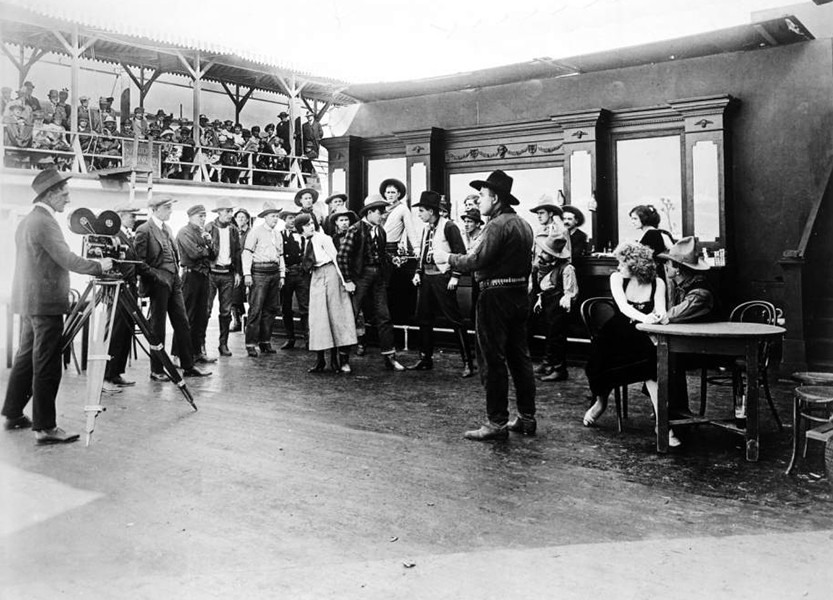 Filming a western on Universal City?s stage, the bleachers of the original tour visible in the background (c. 1915. USC Photo Archive)
Filming a western on Universal City?s stage, the bleachers of the original tour visible in the background (c. 1915. USC Photo Archive)
Later that year, Laemmle reopened Universal City to anyone with 25 cents for admission. With their 25 cents, they could watch the live performances and tapings of their favorite film stars. Laemmle erected bleachers around the studio sets, encouraging audiences to cheer the heroes and boo the villains as the actors mugged for the cameras. For another nickel, they would even get a boxed chicken lunch to eat from the cafe! Between takes, patrons could wander around the stages, collect autographs and visit the zoo. Unlike many other provincial towns, Universal City was home to one of the world?s largest zoos filled with thirty lions, ten leopards, elephants, monkeys, and horses.
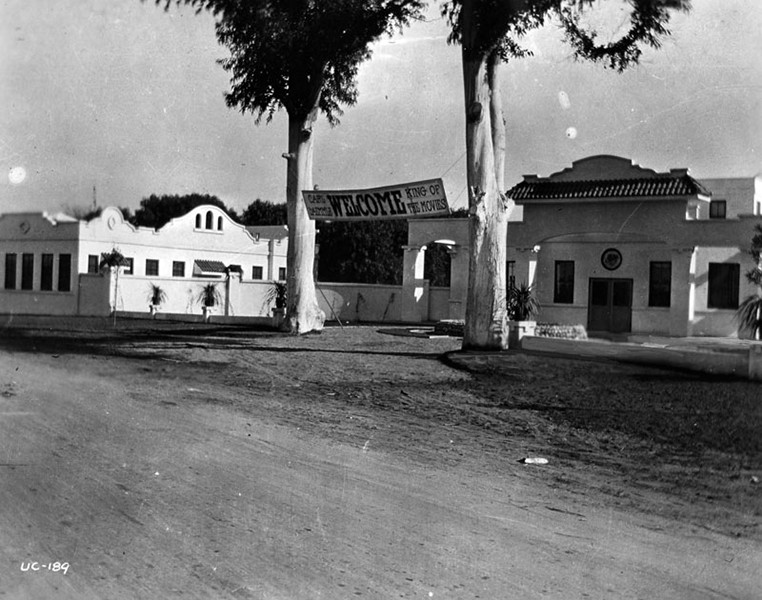
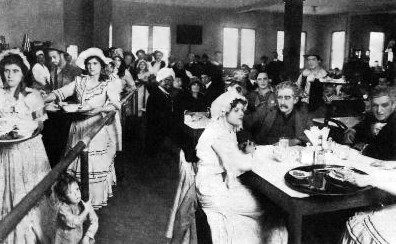
 Universal City as it looked in 1916.
Universal City as it looked in 1916.
Nearby was everything necessary to make movies including eighty dressing rooms (some still standing on the backlot), a mill, shops, a forge, greenhouses, and even company offices with electricity and running water. There were two restaurants and two outdoor stages with muslin screens strung overhead to diffuse the California sunlight. The largest soundstage included a revolving stage and a rocking stage. The floor could be removed and underneath were water tanks that could be combined to appear as a lake. (This stage is actually still there and visible on the present-day Studio Tour!)
Like any municipality, there was a Police Department, a fire brigade, library, a school, and a hospital. All of the buildings in his city were designed so that they could be redressed quickly to simulate any type of environment the film required. One day a building may be a Greek temple and the next a Victorian home.
 Universal City (c. 1915)
Universal City (c. 1915)
In the first year, from 1915?1916, there were 250 pictures produced at Universal City. The studio was such a smashing success that Laemmle?s rival, Thomas A. Edison, visited on October 27, 1915.
The tour remained popular for over a decade. Then, with the advent of sound recording, which required a quiet set, the grandstands were removed around 1930 and visitors were no longer welcome on the studio lot. Hence, the first version of Universal Hollywood?s famous studio tour was put on the shelf for nearly three decades.
Uncle Carl (a nickname he received because he had so many relatives on the payroll) passed away on September 24, 1939, well before the studio was reopened to the public. However, his dream of a city dedicated to the filmmaking arts and open to the public would live on well into the twenty-first century.
The Studio Reopens Its Gates
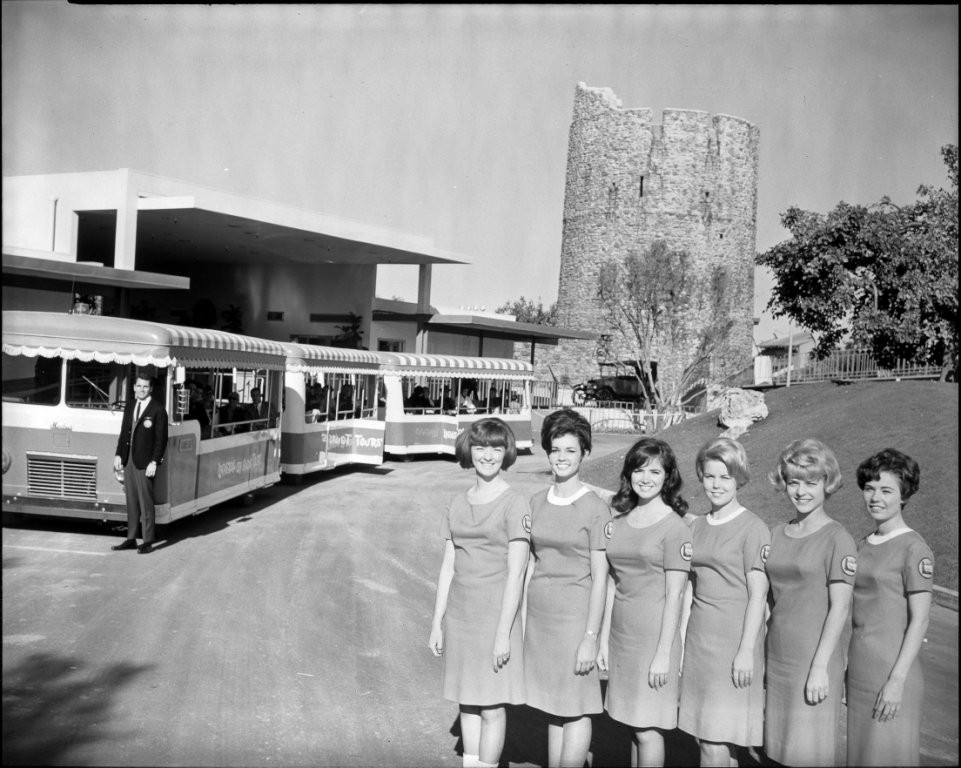 A promotional photo for the new Universal Studio Tour with the Glamor Trams (c.1964)
A promotional photo for the new Universal Studio Tour with the Glamor Trams (c.1964)
By this time Universal City reopened to the public three decades later in 1961, The Music Corporation of America (MCA) had taken over ownership of Universal Pictures. At first, Universal simply outsourced the tours to the Gray Line bus company, the same company that provided tours of the homes of Hollywood stars. The studio charged the bus companies a small fee and also benefited from the extra lunches they could sell to the tourists in the Studio Commissary (film-speak for cafeteria). The bus drivers were given a hand-typed script to read that highlighted the studio facilities as well as hyped upcoming Universal releases.
However, MCA soon began to look for a way to revive the old Studio Tour as part of a new image for Universal City Studios. In 1963 legendary movie mogul Lew Wasserman, then president of MCA Universal asked VP Al Dorskind to look into the feasibility of creating a permanent tour. He, in turn, hired Buzz Price to conduct a feasibility study ? the same man who helped determine the locations for Disneyland and Walt Disney World.
The results must have been positive because Universal decided to embark on its own tram tour of its facilities. The resulting ?Glamor Trams? as they were called were candy-striped and designed by Hollywood art director Harper Goff, made famous by his work on 20,000 Leagues Under the Sea and Willy Wonka. General Manager Barry Upson from the Seattle?s World Fair and designers Randall Duell and Bud Dardene rounded out the team. Together they worked out the transportation, entertainment, and logistics of the route, while also preparing for the future ?Tour Center.
Fun Fact: Shortly before opening in 1964, the guys invited the Universal secretaries on a special test run. Unfortunately, it was the first test run of the Glamour Trams and the tram broke down halfway through in a remote section of the backlot. The poor secretaries had to walk all the way back to their offices on the Front Lot.
Despite the failed test run, the original Universal Studio Tour opened on June 17th, 1964 with tickets being sold out of a temporary trailer on Lankershim Blvd.
 A scene from the backlot on the Universal Studio Tour (c. 1960s)
A scene from the backlot on the Universal Studio Tour (c. 1960s)
The original 90 minute-long Studio Tour cost $2.50 to ride. Visitors rode on two pink-and-white striped ?Glamor Trams? around the studio?s back lot, with stops to see a collection of costumes designed by Edith Head, a makeup demonstration presented by Mike Westmore of the famous Westmore family of makeup artists, a walk through a star?s dressing room, a western stunt show, and ? the big money maker for Universal ? to buy themselves lunch at the studio commissary.
It was a major success, an estimated 38,184 guests rode the Universal Studio Tour in its first year. The next year, the studio tour entrance moved to the park?s current entrance on the Upper Lot of Universal City, and Universal built a permanent arena for the western stunt show next door.
Universal Studios Hollywood opened with a very lean staff, just a couple of tram drivers, another couple of tour guides, a ticket seller and contracted stuntmen for the show.
How the studio tour looked in the 1960s.
In fact, the initial tour guides of the Studio Tour were actually folks Universal Studios Hollywood found working at the studio or relatives of famous people. One of the first tour guides was a guy named John Badham, who is famous for directing Saturday Night Fever and War Games. He got his start as a tour guide at the Universal Studio Tour back in the sixties.
To keep labor costs down while adding more entertainment for visitors, Universal started using audience volunteers to play roles in various scenes throughout the tour. That began a tradition of audience interactivity that eventually spread not just to other Universal theme parks, but to parks run by Disney, SeaWorld, and others, as well.
Bringing the Movies To The Audience ? A New Era of The Studio Tour
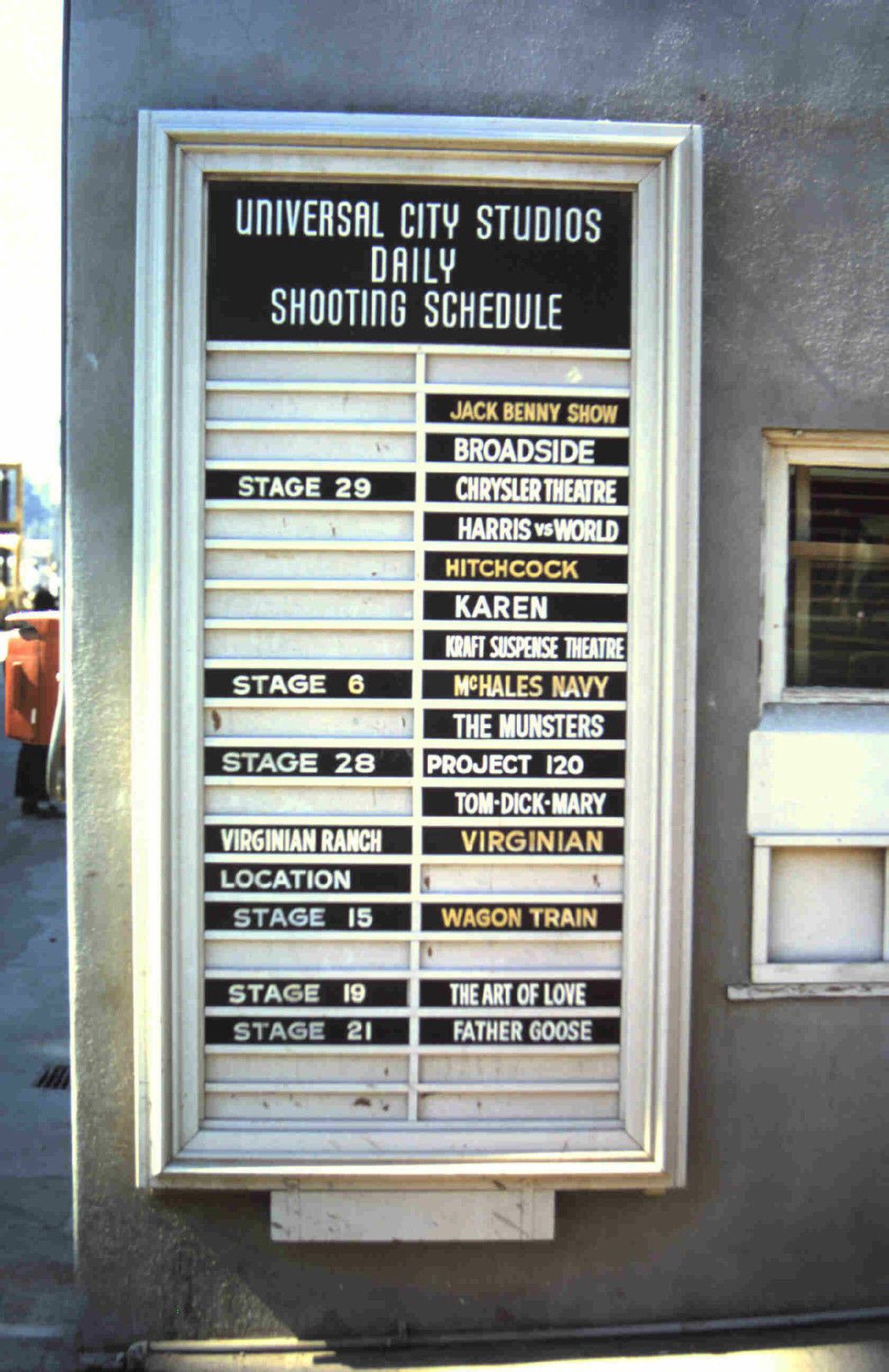
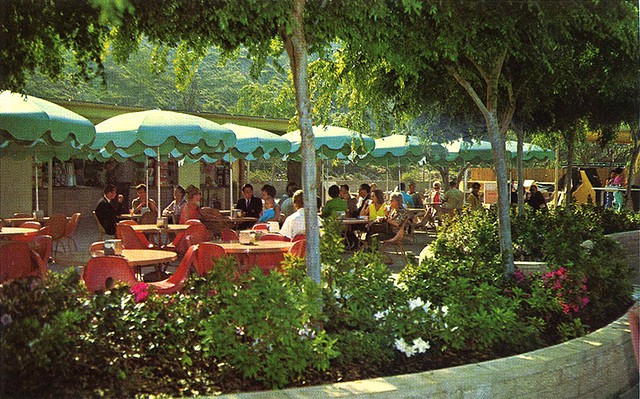 The 1970s at Universal Studios ? Shooting Schedule (Left) and Prop Plaza (Right)
The 1970s at Universal Studios ? Shooting Schedule (Left) and Prop Plaza (Right)
As is the nature of a fully operational Hollywood studio, filming schedules forced Universal to change the tour trams? route through the backlot, on almost a daily basis, an operational consideration that continues to this day if you happen to visit. To keep up the entertainment value of the tour, even on the days when filming closed much of the backlot, and to compete with the nearby Disneyland, MCA Universal began adding fixed attractions to the tour.
The first expansion to the tour was the Prop Plaza, which included the tour?s first ?animation? ? a model T Ford on a mechanical gimbal with a rotating canvas cyclorama.
However, in 1968, the number of film productions Universal could show visitors got even more restricted when the Screen Actors Guild enacted a rule prohibiting visitors from most soundstages. This new rule coupled with more productions being shot on location meant the backlot tram tour could not show visitors much in the way of real movie and television production. Jay Stein, President of Universal?s Recreation Division championed the idea of creating exciting experiences for visitors in place of viewing actual film/TV production.
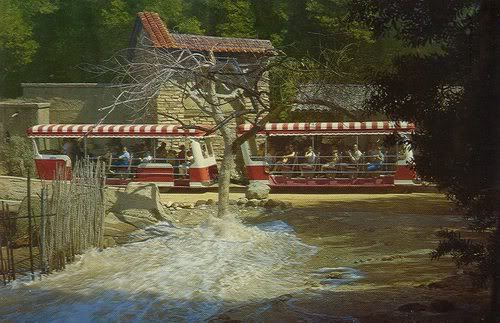 How the Flash Flood set appeared at opening (c. 1968)
How the Flash Flood set appeared at opening (c. 1968)
Later that same year, the Flash Flood set was opened and this first special-effects attraction proved to be a hit. 20,000 gallons of water rushed 200 feet down a narrow Mexican village street, uprooting an old tree and threatening to engulf the tram.

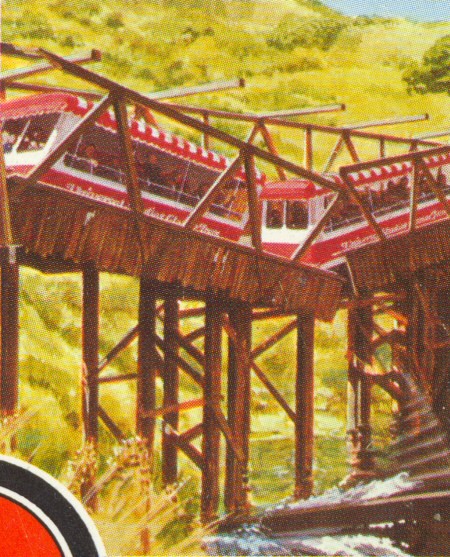 The Parting of the Red Sea set (1973) & The Collapsing Bridge (1974)
The Parting of the Red Sea set (1973) & The Collapsing Bridge (1974)
Later, the parting of the Red Sea (from The Ten Commandments) was added in 1973, the collapsing bridge in 1974, and the Ice Tunnel in 1975. This all cost MCA a cool $4 million dollars. It also required them to invest in an additional fleet of trams, additional dining locations, parking lots, and other necessary facilities. Al Dorskind made a deal with Cal Trans to remove the top of a large hill on the Universal property for a new Tour Center (Cal Trans actually used the dirt in the construction of the Hollywood Freeway). The Tour Center eventually became the top deck of the Universal Studios Theme Park.
 The Jaws Experience (2000s)
The Jaws Experience (2000s)
By the 1970s, MCA was spending millions more on updates to the tour, including a spectacular rockslide display and the Jaws Experience, added in 1976. Based on Steven Spielberg?s break-out hit from the previous year, Jaws recreated the village of Amity from the movie, with a 25-foot animatronic shark emerging from the water to attack the tram. An immediate hit, Jaws created the template for future big-budget, dedicated Studio Tour attractions based on enduring Universal films.
However, many of the early tour attractions did not stand the test of time and have been replaced over the years to make way for new expansion. Theme park aficionados will fondly recall such quirky attractions as the Submarine Attack, The Avalanche, The Runaway Train, The Burning House, The Ice Tunnel, Battle of Galactica and perhaps the strangest attraction of all?a mechanical gorilla holding a severed human arm that used to ?swing? through Tarzan?s Jungle.
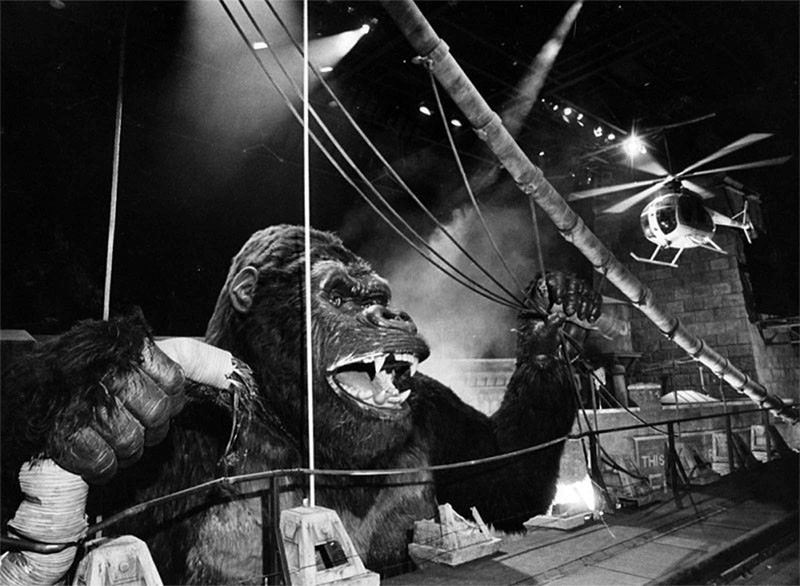 The King Kong Experience [Herald Examiner Collection at Los Angeles Public Library]
The King Kong Experience [Herald Examiner Collection at Los Angeles Public Library]
In 1986, Universal added an even bigger attraction, installing the King Kong Encounter in a 26,000-square-foot New York-themed soundstage. The Kong animatronic, the largest in the world at the time, was built by Bob Gurr, who also created most of the ride vehicles for the nearby Disneyland. Kong weighed in at seven tons, measured over 30 feet tall, was covered in 660 pounds of fur and had a bad case of banana breath. He was modeled after the star of Dino de Laurentis? 1976 movie version. He was the largest and most complex animatronic figure in existence for many years. The attraction broke new ground and paved the way for the complex themed attractions of today and was the inspiration behind the former Kongfrontation attraction at Universal Studios Florida.
Unfortunately, Kong was completely destroyed by some of the massive fires that have plagued Universal Studios Hollywood since opening. His fate was sealed in a particularly nasty one that took place on the backlot in the early morning of June 1, 2008. In 2010, the entire King Kong Encounter attraction was replaced with King Kong: 360 3-D.
 Earthquake: The Big One (1988)
Earthquake: The Big One (1988)
In 1988, Universal added its third iconic Studio Tour attraction, Earthquake: The Big One, another themed soundstage, where the trams shook and bobbed during a simulated 8.3 San Francisco earthquake. The next year, Universal Studios Hollywood has a record year for attendance, with visitors increasing by 21%, which they attributed to the runaway success of the Earthquake attraction.
Of course, the biggest and most unpredictable ?attraction? of the Studio Tour has always been the prospect of seeing a movie star. Since its inception, the Studio Tour has strived to get guests as close to filmmaking as possible. This necessitates daily, sometimes hourly, changes to the tour route. Over the years, the tram has had some rather unique encounters with Hollywood stars including a head-on collision with John Travolta?s Rolls Royce (Mr. Travolta signed autographs and posed for pictures with the surprised guests) and being terrorized by a rubber knife-wielding Mother Bates at the Psycho house (actually Jim Carrey in disguise)!
In the Summer of 2000, Universal brought the tram into the 21st Century with the debut of The New Studio Tour with the inclusion of LCD video monitors, a state-of-the-art audio system, onboard video cameras and DVD players containing over 200 pieces of custom produced media. For the first time ever, guests were able to see examples of how the Universal lot has been used for motion picture and television production. It also offered the opportunity for NBC Universal synergy as the tour is now hosted by Jimmy Fallon of The Tonight Show (which doesn?t even film on site).
From a World-Famous Studio Tour to a World-Class Theme Park
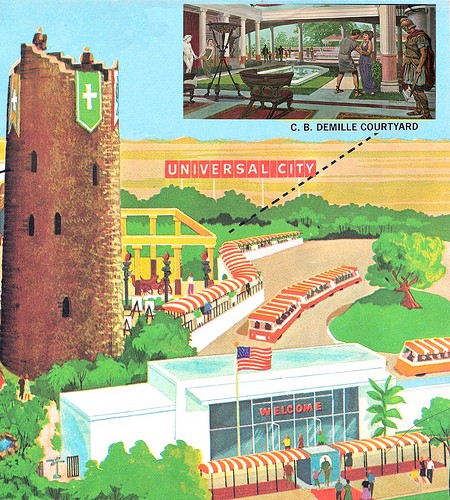 The Original Upper Lot of the ?Theme Park? ? The Welcome Center and Studio Tour
The Original Upper Lot of the ?Theme Park? ? The Welcome Center and Studio Tour
I know what you?re thinking? Where did the theme park come in?!
Well, at Universal Studios Hollywood, the theme park really evolved around Universal?s long-standing production lot. Constrained between production facilities and unforgiving mountain geography, Universal Studios Hollywood lacks the hub-and-spoke or central lagoon design that define so many other theme parks, including Universal?s Orlando Parks. Instead, Universal Studios Hollywood meanders across a mountain top, with a second level below, accessible via a series of massive escalators added in the 1990s.
At first, Universal simply added new attractions to the Upper Lot over the years to complement the Studio Tour, organically continuing the park?s evolution from tour to full-day theme park. The first edition was in 1965, the Visitor?s Entertainment Center, which was built at a cost of $5 million on the main Upper Lot. A press release for the new center stated that this is ?where special effects are illustrated along the movie streets of the world?.
Ma and Pa Kettle Farm, also called Ark Park, was introduced later around 1967 and featured animals that were used in many Universal productions. Visitors could stroll at their leisure to pet and feed the animals. Starting in 1970, there were also regularly scheduled shows under the direction of Ray Berwick, famed animal trainer best known for training the hundreds of birds for Alfred Hitchcock?s ?The Birds? on the newly-constructed Animal Actors? School Stage.
In 1972, Universal actually played host to concerts! The Amphitheatre opened as an outdoor daytime arena to replace the original Stunt Show arena. But, as the venue was idle after sundown, a young tour employee apparently suggested holding rock concerts in the arena after the stuntmen had gone home. The first music performance was the Los Angeles premiere of ?Jesus Christ Superstar? on June 28, 1972. The new Amphitheatre?s musical events proved instantly attractive and soon the Universal Amphitheatre became the favorite showcase of the world?s leading concert performers. A roof was later added and it remained a Universal City fixture until September of 2013 when it was demolished in preparation for The Wizarding World of Harry Potter, which debuted on the Upper Lot in 2016.
Just 3-years after the amphitheater was built, in 1975, following the success of the smaller makeup show on the studio tour, an 1500-seat outdoor arena was prepared for the much grander The Land of a Thousand Faces show. After it?s four-year run, an even more elaborate makeup and special effects show was planned for the theatre. Universal quickly constructed a roof for the theatre and staged a spooky Castle Dracula stage show featuring Universal?s classic horror monsters in 1980. Throughout the years, the Castle Theatre has seen movie themed live productions come and go including Fear Factor Live, Beetlejuice Graveyard Revue, and currently hosts the Special Effects Stage Show.
In 1991, Universal Studios Hollywood expanded onto the Lower Lot with the opening of a quarter-mile series of escalators connecting the top and bottom of the mountain upon which Universal City was built. In 1991, E.T. Adventure opened as the park?s first ?dark ride,? before being replaced by Revenge of the Mummy in 2003. E.T. Adventure can still be experienced at Universal Orlando in Florida. Today, the Lower Lot is home to the Jurassic Park River Adventure (soon to be Jurassic World), Revenge of the Mummy and Transformers: The Ride 3D.
In 1993, the first high-technology thrill ride opens, positioned at the edge of the Upper Lot; the simulator-driven Back To The Future ? The Ride based on Robert Zemeckis? 1985 film. Later, this was replaced with The Simpsons Ride.
Discover The History ? Visiting Universal Studios Hollywood of Yesteryear Today
 Denver Street (on the right) beside the Tower of London set (on the left) [From ?Inside Universal Studios?, 1978]
Denver Street (on the right) beside the Tower of London set (on the left) [From ?Inside Universal Studios?, 1978]
Universal Studio Hollywood is always evolving, always innovating, always improving. When it?s time to make room for new amazement, saying goodbye to old favorites is never easy. However, Universal Studios Hollywood is perhaps the only theme park in the world where saying goodbye is a given and not a possibility. In the last 55 years, with well over 50 theme park attractions having been shuttered to make way for new attractions like Despicable Me Minion Mayhem, The Walking Dead Attraction, and The Wizarding World of Harry Potter.
Despite this constant evolution, you can still experience elements of the original Universal City and the 1960s version of The Studio Tour.
On the World-Famous Studio Tour, look out for the following original elements:
- Flash Flood Set ? The first special effect sequence was created in 1968 and still holds a place on the Studio Tour today.
- Production Bungalows ? Many of these bungalows were built in the 1940s?1960s and they would have been ?The Stars Dressing Room? you would have toured on the 1964 verison of the Universal Studio Tour. Throughout the 60s, these were home-away-from-home dressing rooms for stars like Alfred Hitcock, Doris Day, and Lucille Ball. Although they have been converted into production offices and you no longer get to walk through them, they are still usually present on the Studio Tour.
- Wild West Town (Denver Street)? Although the original Denver Street would have been present when the Studio Tour opened in 1964, a fire destroyed much of it and a replica was built in 1967. These sets look similar to that which you would have encountered in 1915 when you paid your 25 cents to watch your favorite westerns being filmed. However, these original sets were in a different location on the front lot.
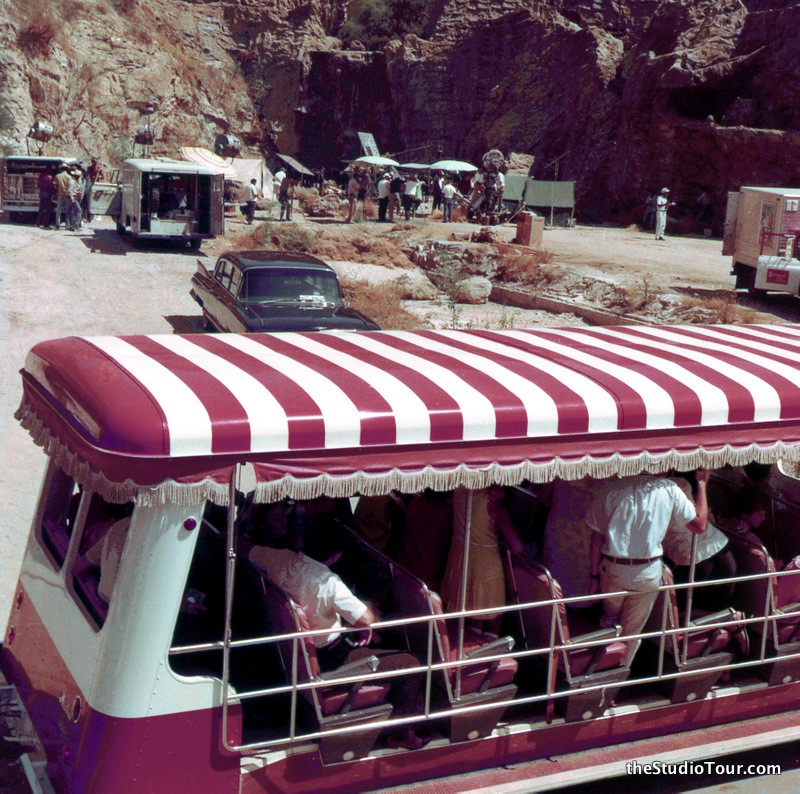 Falls Lake and The Studio Tour (1964)
Falls Lake and The Studio Tour (1964)
- Falls Lake ? Falls Lake was first constructed in 1926 for the early Universal classic Uncle Tom?s Cabin and was named after a massive waterfall flowing down fake ?cliffs?. Although often covered up for filming, Falls Lake is still usually a part of the studio tour.
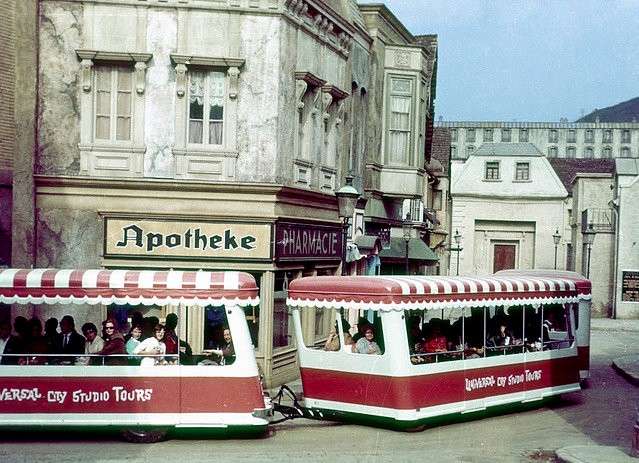 GlamorTram in Little Europe (postcard) [Scan from the Dickens Collection]
GlamorTram in Little Europe (postcard) [Scan from the Dickens Collection]
- Little Europe ? Although the Little Europe sets date back to the 1920s, the current sets were built in 1967 as replicas of the old sets, following the same devastating fire in that year which destroyed Denver Street. You would have seen these sets on the original Studio tour.
The Legacy of Universal City
Although much of the original Universal City may not remain, the lasting ramifications of Universal Studios Hollywood and the original theme park studio tour still reverberate across the industry with theme parks around the world including Disney?s Hollywood Studios and Disney?s Walt Disney Studios Park in Paris, not to mention the Universal Parks in Japan, Florida, and soon to be China, still taking cues from what Universal Studios Hollywood was doing way back in 1915.
The creation of the Jaws Experience addition to the studio tour in 1976 set the level for auto-animatronic engineering in the theme park industry and not only did it create the template for future big-budget, dedicated Studio Tour attractions based on enduring Universal films, it was the inspiration for the former Jaws attractions in Universal Studios Florida and also started a pattern of MCA executives thinking bigger. In the early 1980s, MCA Universal executives devised a plan to expand their studio tours concept to Florida. The Florida tour was to be similar to the Hollywood version and would be built around a brand-new, working production facility. The plans called for a ?front lot? walking tour, as well as a tram tour through the studio?s backlot.
Later, in 1986, the great success Universal Hollywood experienced in the first year following the King Kong Encounter?s addition to the Studio Tour convinced management to move the Florida idea forward. It was the largest and most complex animatronic figure in existence for many years, but it also paved the way for the complex themed attractions of today and was the inspiration behind the former Kongfrontation attraction at Universal Studios Florida.
In December of 1986, MCA announced Cineplex Odeon Corp., a Toronto-based entertainment company 50 percent owned by MCA, would be an equal partner in what would now be known as Universal Studios Florida.
Visiting Universal Studios Hollywood
Want to visit Universal Studios Hollywood and discover the legacy of filmmaking? Tickets start at $109. Purchase your tickets online.
However, if you are passionate about discovering the historic sites of the backlot, I would recommend splurging for the VIP Experience as it includes behind-the-scenes access to the backlot. Tickets for the VIP Experience start at $349.
Austin is based in Southern California and is the Creator and Host of Fastpass to the Past: The Theme Park History Podcast. Listen today on your favorite podcast platform to learn more interesting tidbits about Universal Studios and Theme Park History.
